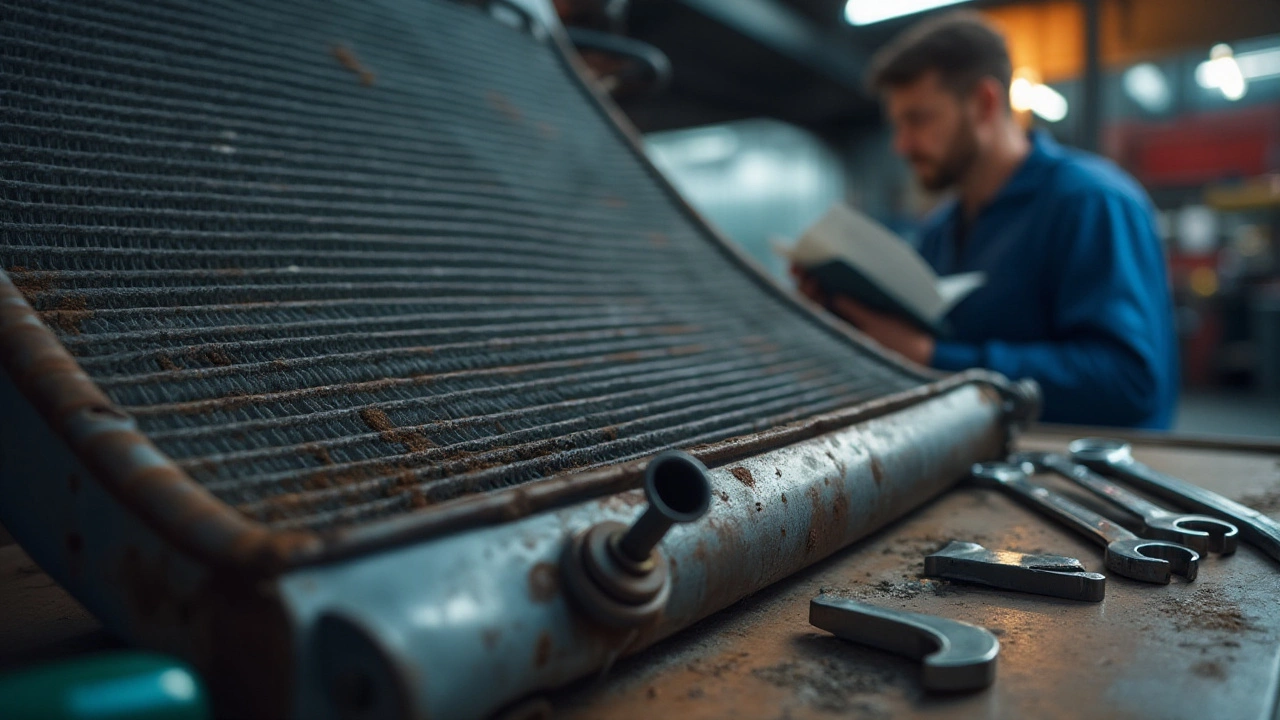It's no secret that your car's radiator plays a vital role in keeping the engine functioning smoothly. Imagine this scenario: you’re cruising down the highway, enjoying the ride, when suddenly the temperature gauge spikes into the red zone. At this point, you might begin thinking about that neglected radiator issue.
The journey of understanding radiators begins with how they manage engine heat. Essentially, they are the vehicle's cooling system, and they ensure that the engine doesn’t overheat. When your radiator isn’t in top shape, not only is your car’s performance compromised but you also run the risk of significant engine damage.
For drivers unaware of what a faulty radiator means, the risks can be far-reaching. From the inconvenience of unexpected breakdowns to potentially dangerous situations, knowing the early warning signs can save you both time and costly repairs. Whether it’s persistent leaks, steam billowing out from under the hood, or unusual temperature readings, addressing these issues can mean the difference between a smooth journey and a roadside emergency.
Let's unravel what it means to drive with a malfunctioning radiator and delve into maintenance habits that will keep your vehicle ready for the road. You'll find not just tips but a call to be proactive, ensuring that your radiator—and your car—is always at peak performance.
- How Radiators Work
- Risks of Driving with a Bad Radiator
- Signs of Radiator Trouble
- Preventive Maintenance Tips
How Radiators Work
Getting to grips with how a car radiator functions is akin to understanding the heartbeat of your engine. Essentially, it’s the principal component of your vehicle’s cooling system, playing a crucial role in maintaining an optimal engine temperature under various driving conditions. As you drive, your engine generates a significant amount of heat; without a mechanism to dissipate this heat, your engine would overheat and potentially seize up. The radiator is precisely this mechanism, likened often to a vehicle's external cooling fan.
The radiator works by transferring the heat from the hot coolant flowing through it to the air blown by the fan. The coolant is a special liquid that circulates in the engine block, absorbing heat and taking it to the radiator. Here’s where the magic happens: as the liquid enters the radiator, it's distributed over an array of thin tubes. Air flows around these tubes, courtesy of the fan attached to the radiator or the forced air when the car is in motion, cooling the liquid. This process of heat exchange is finely balanced and critically important.
Interestingly,
"The efficiency of a car radiator is essential in ensuring the engine's longevity, preventing both mild overheating and more catastrophic failures," asserts Jake Fisher, Senior Director of Auto Testing at Consumer Reports.Over the years, the design of radiators has evolved significantly. Traditional models were typically made from copper and brass, known for their excellent thermal conductivity. However, in the quest for automotive innovation, modern radiators are often aluminum-based, offering the benefits of lighter weight while retaining considerable conductive properties. This shift has contributed to enhanced vehicle performance and fuel efficiency.
Another critical component of radiator function is the thermostat, a simple but vital device that regulates the flow of coolant based on the engine’s temperature. When the engine coolant reaches a certain temperature, the thermostat opens, allowing coolant to flow to the radiator, where it's cooled before re-circulating. Without a functioning thermostat, your car radiator cannot effectively manage the engine's temperature, leading to overheating or underheating.
One might wonder how the radiator maintains its integrity despite being exposed to high pressures and extreme temperature variations. The secret lies in its durable construction and the use of quality materials that can withstand the extremes of automotive operation. Almost every part of the radiator, from the tubes to the tanks, is engineered to endure the demanding environment of a car’s engine bay. The understanding of these components and maintenance practices can undoubtedly help prolong the life of the radiator and thereby the engine.
Looking at the numbers, a properly functioning radiator can help maintain engine temperatures between 195 and 220 degrees Fahrenheit, though every vehicle might have its specified optimum range. Keeping temperatures within this range ensures efficiency, performance, and longevity of the car.

Risks of Driving with a Bad Radiator
Having a faulty car radiator can spell disaster for your vehicle, and ignoring the signs is like dancing on a cliff's edge. The primary role of a radiator is to prevent the engine from overheating by efficiently dissipating heat. When this system breaks down, it's akin to your body losing its ability to regulate internal temperature. Driving with a bad radiator means heat buildup, which can lead to critical engine failure. Imagine cruising through city traffic only to have your engine seize up unexpectedly, leaving you stranded. This is one of the many scenarios that can unfold if radiator issues go unresolved.
If left unchecked, an overheating engine can suffer from warped components, blown gaskets, or worst yet, a cracked engine block. Repairs of this magnitude aren't just costly; they're a significant blow to your vehicle's longevity and your wallet. A study by the American Automobile Association (AAA) highlights that engine-related failures are among the top reasons for roadside assistance calls, emphasizing the underestimated role of the radiator in car health. Increased fuel consumption often accompanies overheating issues, as your vehicle compensates for the loss of efficiency. This means more frequent stops at the gas station and more money spent on fuel each month.
A critical but often overlooked consequence of a faulty radiator is its impact on the environment. An engine that's not adequately cooled tends to burn fuel less efficiently and releases more pollutants into the atmosphere. This aspect is particularly concerning in today's eco-conscious era. Studies show that well-maintained engines significantly reduce carbon footprint, and neglecting your radiator's health counteracts such efforts. In cars with impaired radiators, you may also notice a decrease in power output, as the engine struggles under the duress of excessive heat, reducing your vehicle's overall performance. Picture climbing a steep hill, only to feel your car lagging; this could be your engine crying out due to inadequate cooling.
While it might be tempting to soldier on with a compromised radiator, the risks far outweigh any temporary convenience. If you sense your car might be overheating persistently or observe that fluids are leaking from your radiator, it's time to act. Staying informed and proactive about your car maintenance not only secures your safety but also extends your vehicle's lifespan. A repair now, or even a replacement, can save you from a cascade of troubles down the road, offering peace of mind each time you get behind the wheel.
"Regular maintenance is your best defense against unexpected breakdowns," emphasizes Tom Magliozzi, renowned auto mechanic and co-host of NPR's Car Talk. Addressing radiator leaks or overheating promptly makes all the difference between smooth driving and roadside dilemmas.

Signs of Radiator Trouble
It’s easy to overlook the subtle hints your car gives you when the car radiator starts to act up. Understanding these signs can save you from the headache of being stranded on the side of the road. One of the most obvious indications of trouble is when the temperature gauge needle begins to climb towards the higher end, inching closer to the red zone. This gauge is your first line of defense, alerting you when conditions under the hood are heading towards a boiling point.
Leaking coolant is another telltale sign. You might notice puddles of neon green, orange, or pink liquid beneath your car; this is coolant and it’s supposed to be inside your engine, not on your driveway. Usually, such leaks hint at a compromised radiator which can no longer hold the coolant under pressure. Moreover, the color of the coolant can sometimes indicate the type being used, which is integral for understanding what precisely your car needs.
A persistent sweet smell coming from the front of your vehicle can also be a harbinger of radiator issues. This odor often accompanies antifreeze leaks. Occasionally, steam billowing from under your hood when you come to a halt is another concerning visual clue. At this point, continuing to drive could result in catastrophic engine damage.
Listen closely to your vehicle and any new, unfamiliar noises. Sometimes, a failing radiator fan produces a noticeable whirring or clunking sound. This fan is crucial in dissipating the heat produced by the engine, especially during idle or slow-moving traffic. A weak fan performance reduces the efficiency of the cooling process, causing an increase in temperature.
Also, it’s worth checking the radiator cap. An underperforming or worn-out cap might not maintain the pressure needed to keep coolant circulating effectively. It could mean the difference between keeping the coolant from boiling away and staring at a dashboard flashing an engine overheat warning.
If you regularly see dirty or rusty water when checking the coolant level, this is another concern. It might mean that rust or debris from the radiator is circulating through the cooling system, which can lead to blockages or inefficiencies in heat dissipation.
“Temperature fluctuations and frequent coolant top-ups are key warning signals that your radiator could be headed for trouble,” states Jeremy Greenstein, a longtime auto technician with over 20 years of experience. “Ignoring these signs just once can result in more serious engine problems down the line.”
With these warning signs in mind, you’re in a better position to act swiftly when issues arise. Regular checks and maintenance not only help spot these problems early but can also be a game changer in extending the life of your vehicle’s cooling system.

Preventive Maintenance Tips
A well-maintained car radiator is critical to ensure that your car runs like a well-oiled machine, avoiding unpleasant surprises when you least expect them. Regular checks and basic maintenance can drastically reduce the chances of radiator failures. Start by making it a habit to check the coolant levels once a month. The coolant acts like your engine's lifeblood, circulating through the system and keeping temperatures in check. Low coolant levels could hint at a leak, which might seem insignificant at first but could quickly evolve into a major problem if left unchecked.
Beyond just checking levels, it's vital to make sure that the coolant mixture is balanced. A 50/50 mix of water and antifreeze typically provides the best protection against freezing and overheating. Should you notice discoloration or debris floating in your coolant, it's a sign that a flush may be needed. Flushing the system helps to remove rust and deposits that can clog the pathways, inhibiting the crucial flow of coolant.
In addition to upkeep of the coolant, inspect the hoses linked to your radiator frequently. Over time, these can become brittle and may develop cracks, leading to leaks. Ensure there're no bulges or signs of wear where the clamps are located. A simple squeeze test can reveal potential problems; if you feel any crunchiness or stiffness, that’s an indicator that it’s time to replace them.
Regular cleaning can't be stressed enough. Dirt, leaves, and other debris often find their way into the radiator grill, particularly if you frequently drive in rural or wooded areas. A blocked grill reduces airflow, compromising the radiator's ability to dissipate heat. Use a soft brush to clear these obstructions, ensuring the path for air circulation remains unhindered.
Don't overlook the radiator cap, which plays an essential role in maintaining pressure within the system. Over time, the cap's seals may degrade, diminishing its capacity to hold the necessary pressure, leading to coolant loss or boiling over. Always replace your radiator cap with the correct type specified for your vehicle, as variations in pressure ratings can affect overall engine performance.
Periodically, professional inspections should also be on your radar. Visiting a professional mechanic at least once a year for a complete cooling system check can save you a lot of trouble. These inspections often include pressure testing, where a technician uses specialized tools to check for leaks that aren’t immediately apparent.
As renowned automotive expert Jay Leno once said, "Preventive maintenance is like brushing your teeth—sometimes it feels tedious, but in the long run, your car and your health will thank you."
Employing these maintenance measures will not only extend the life of your radiator but will also ensure that your vehicle remains reliable throughout its journeys. When it comes to cars, preventive care isn’t just about avoiding inconvenience; it’s about preserving your investment and keeping you and those on board safe.






